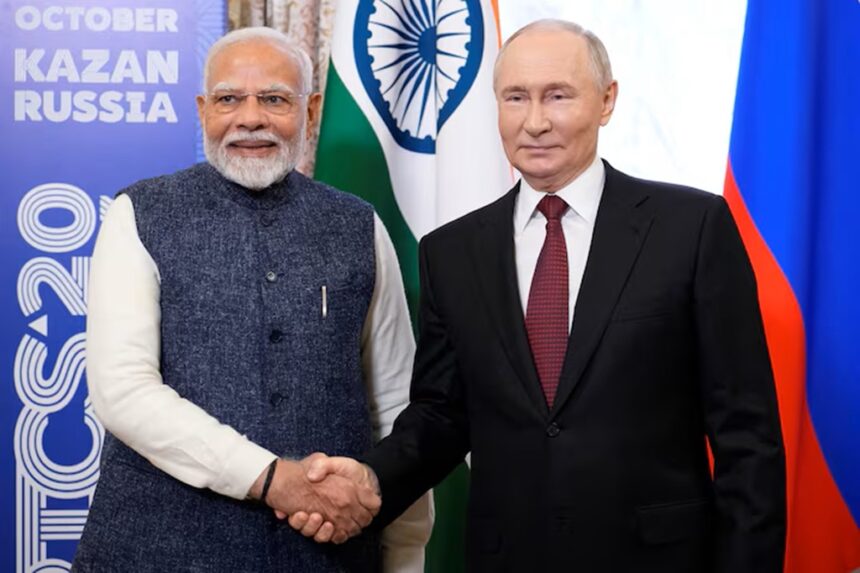MUMBAI – Indian Prime Minister Narendra Modi is under growing criticism for India’s ongoing purchase of Russian oil amid the Ukraine conflict. While Modi continues to call for peace and diplomacy on global platforms, many argue that India’s trade with Russia, especially in oil, helps finance Moscow’s military actions in Ukraine.
This economic partnership, combined with similar moves by China, has led to harsh criticism and claims that New Delhi’s approach undermines its own calls for an end to the war.
Since Russia invaded Ukraine in early 2022, India has become one of the biggest buyers of Russian crude oil. Lower prices, driven by boycotts and sanctions from Western governments, made Russian oil a cheaper option for India. Western officials and other global observers argue that India’s purchases allow Russia to continue funding its war, undermining efforts to isolate Moscow economically.
The gap between Modi’s public calls for peace and India’s sharp rise in Russian oil imports has led critics to claim that the country is putting financial interests above ethical concerns.
How Much Russian Oil Is India Buying?
India is the world’s third-largest importer of oil. Its reliance on Russian oil has soared since the Ukraine war began. According to Kpler, a data firm, India’s imports of Russian crude jumped from 68,000 barrels per day in January 2022 to as much as 2.15 million barrels per day by May 2023. By 2023, almost 40% of India’s oil imports came from Russia, compared to only 2.5% before the war.
Government data shows that India spent $50.2 billion on Russian oil in the financial year 2024-25, making Russia its main supplier and overtaking Iraq and Saudi Arabia.
Discounted Russian oil has helped India lower energy costs and keep fuel prices steady at home. Indian officials, including Energy Minister Hardeep Singh Puri, say these deals kept global oil prices from rising even higher, suggesting that without India’s purchases, prices might have reached $130 per barrel in 2022.
They also argue that buying Russian oil under the G7-EU price cap (set at $60 per barrel and later moved to just over $47) falls in line with global trade rules.
Still, critics highlight the scale of India’s Russian oil imports—now averaging 1.75 million barrels a day from January to June 2025. Many see this as billions in revenue for Russia’s war.
Social media posts accuse India of profiting by buying discounted oil, refining it, and selling the products abroad, which some say indirectly supports Russia’s continued aggression.
Other Oil Suppliers Available to India
India’s move towards Russian oil is driven by cost, but it has options. Before the Ukraine war, India relied mostly on Middle Eastern suppliers, with Iraq, Saudi Arabia and the UAE together providing most of its oil.
These countries can still supply India, but their oil often comes at higher prices because of what’s known as the “Asian premium” from OPEC+ nations, which makes their crude less competitive compared to Russian discounts.
The US, Canada, Brazil and Norway also supply oil, and Indian Oil Corporation has recently bought from some of these countries, showing a degree of flexibility. Iran is another possible source if India can navigate US sanctions, while other OPEC+ members might also step up if market needs change.
Yet, shifting away from Russian crude has challenges. Indian refineries are built to handle the heavy, sulphur-rich oil Russia sells. Switching to lighter oils would need upgrades and extra investment. Long-term supply deals and existing transport links with Russia also make quick changes hard.
Vishnu Varathan from Mizuho Securities says India would have to search the world for deals matching Russian prices, which could drive up costs and disrupt supply. With 70% of Russia’s oil exports heading to India in 2024, the challenge of finding reliable, affordable alternatives is clear.
Pressure from Trump on India
US President Donald Trump has strongly criticised India’s Russian oil trade. On 30 July 2025, Trump set a 25% tariff on Indian goods, citing India’s ongoing imports of Russian oil and arms.
He threatened more tariffs, and warned of 100% tariffs on any country buying Russian oil unless Russia agrees to peace talks by 8 August 2025. On his social media, Trump accused India of ignoring the war’s toll on Ukraine and profiting by reselling refined Russian oil.
Stephen Miller, Trump’s former deputy chief of staff, said on Fox News it was “astonishing” that India is now matching China as a top Russian oil buyer. He argued these purchases allow Russia to keep funding its war. The pressure from Trump reflects US frustration with President Putin’s refusal to negotiate, with India and China seen as blocking attempts to isolate Russia.
Trump’s threats have put strain on US-India ties, which once featured warmth between him and Modi. Indian officials have pushed back. Foreign Ministry spokesperson Randhir Jaiswal called the US stance “unjustified and unreasonable.”
Indian representatives have also pointed out that the EU traded goods with Russia worth €67.5 billion in 2024, and that the US still buys Russian uranium and fertilisers. India argues its trade with Russia is about meeting the needs of its 1.4 billion citizens.
Modi Tries to Balance Economic and Political Pressures
Modi’s government faces a tough balancing act. India’s long-standing non-alignment policy values independence and practical choices. Discounted Russian oil has helped control inflation and protect the rupee. Companies like Reliance Group have also gained, with their shares up by a third since the war started. Yet India’s stance risks trade problems with the US, its biggest export partner, where a $45 billion surplus is now at risk.
Critics argue that as long as India is a main buyer of Russian oil, Modi’s talk of peace rings hollow. Former Indian foreign secretary Shyam Saran said India’s shift to Russian oil was driven by market needs after Western sanctions pushed other suppliers towards Europe. Still, the reality of India benefiting from Russian trade while talking about peace has drawn accusations of selfishness and moral compromise.
Global Effects of India’s Oil Choices
India’s Russian oil trade matters beyond its own borders. If Indian imports of Russian oil dropped, the world could face a 2% reduction in global supply, which could drive prices above $80 per barrel.
JP Morgan analysts say Russia could respond by stopping the CPC pipeline to Kazakhstan, which would affect some major US oil companies and further tighten global supplies. These risks show how hard it would be for India to quickly find other suppliers and avoid diplomatic fallout.
As the Ukraine war continues, Modi’s government must weigh its economic needs against rising international criticism. While India claims that its oil deals help global markets, opponents argue that they keep Russia’s military campaign alive. With new US tariffs and rising costs for alternative oil, how New Delhi responds in the coming months will shape its ties with Washington and its broader role on the world stage.














